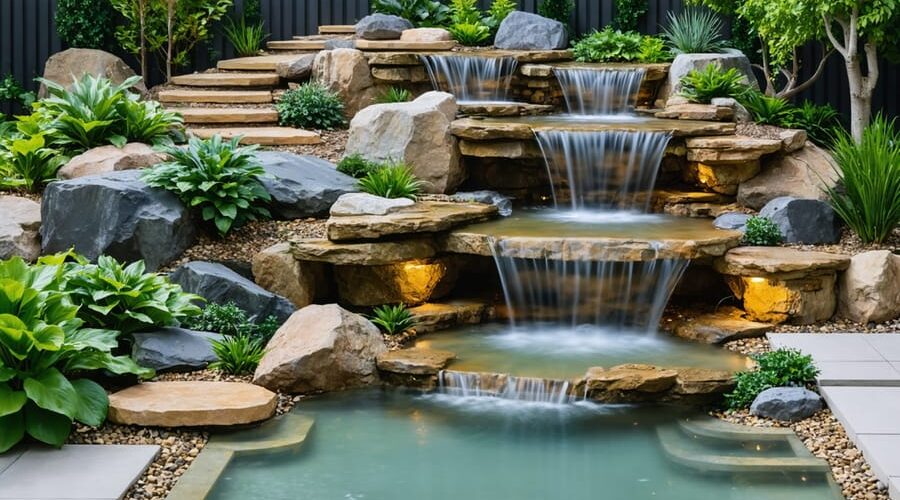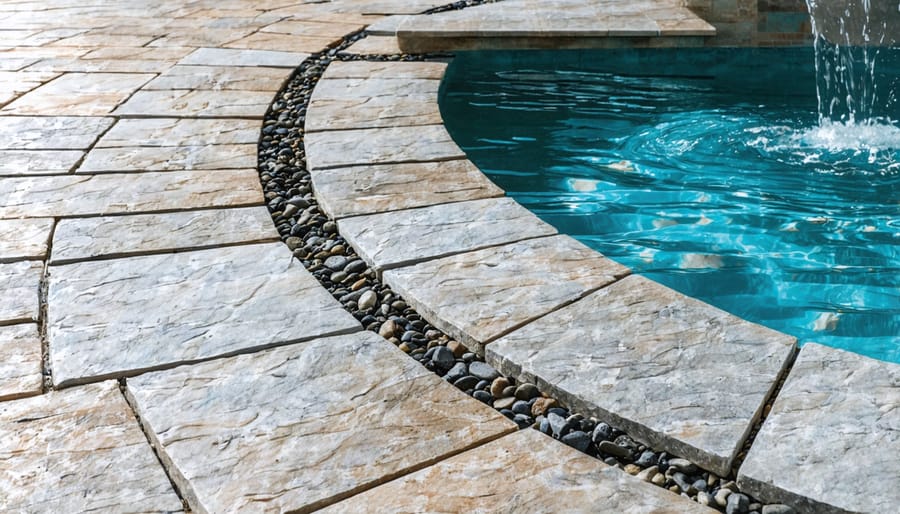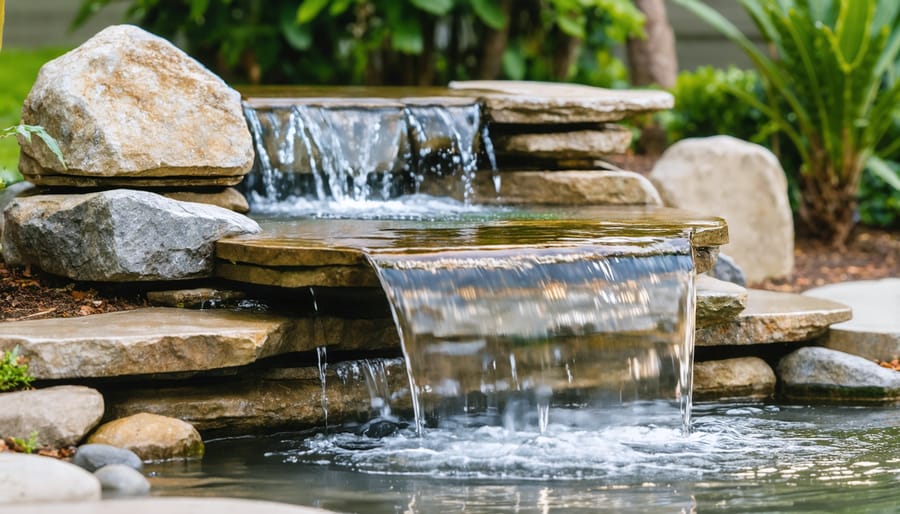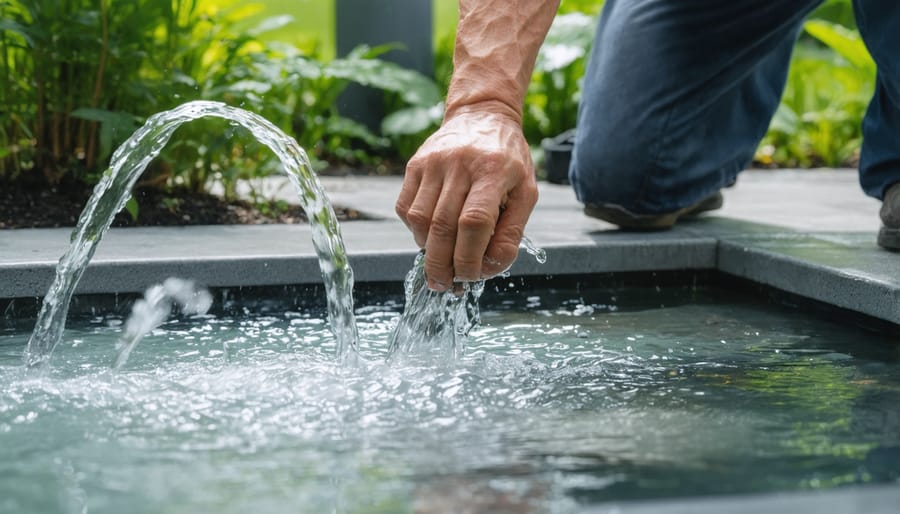
Beautiful Water Features That Keep Your Family Safe (Expert Design Tips)
Transform your outdoor space into a mesmerizing oasis by integrating flowing water features that both captivate and protect your family while enjoying water features. Strategic placement of cascading waterfalls, reflective pools, and bubbling fountains creates distinct zones of tranquility while maintaining clear sightlines for supervision. Layer your water feature design with varying heights and depths – shallow streams perfect for gentle splashing, elevated fountain displays for visual drama, and strategically placed boulders that double as safety barriers and natural seating areas.
Modern landscape water features blend seamless safety features with stunning aesthetics: non-slip surfaces surrounding water edges, subtle lighting that illuminates pathways after dark, and child-resistant barriers disguised as decorative elements. These thoughtful design elements work together to create an outdoor sanctuary that delights the senses while maintaining peace of mind for the whole family.
The key to successful water feature design lies in balancing visual impact with practical functionality – incorporating proper filtration systems, selecting appropriate plants for natural purification, and ensuring easy maintenance access points that preserve the overall design aesthetic.
Essential Safety Considerations for Water Feature Design
Depth and Edge Design
When designing water features, safety should be your top priority, starting with proper depth considerations. For decorative ponds without fish, maintain a depth of 18-24 inches, which provides enough water volume for stable temperatures while remaining relatively safe. If you’re planning to keep fish, aim for at least 2-3 feet deep to protect them from predators and temperature fluctuations.
Edge design is crucial for both safety and aesthetics. Consider implementing a gradual slope with multiple tiers, creating a natural-looking transition from shallow to deep areas. Include a shelf around the perimeter that’s 8-12 inches deep and at least 12 inches wide – this serves as both a safety ledge and a perfect spot for marginal plants.
For extra protection, especially in areas with children, incorporate stone barriers or protective edging that rises 2-3 inches above ground level. This prevents accidental slipping into the water while maintaining visual appeal. Beach-style entries, where the edge gradually slopes into the water like a natural shoreline, offer both safety and aesthetic benefits.
Remember to include non-slip materials on walking surfaces around the water feature, and consider installing underwater lighting to improve visibility during evening hours. These thoughtful design elements ensure your water feature remains both beautiful and secure.
Non-Slip Surfaces and Materials
Safety should never take a back seat to aesthetics when designing water features. Selecting the right non-slip materials for your surfaces is crucial in preventing accidents, especially in areas that frequently get wet. Natural stone with a rough texture, like slate or textured granite, provides excellent traction while maintaining an organic look. For pathways and surrounding areas, opt for materials like exposed aggregate concrete, which combines safety with durability.
Consider installing rubber-based coating or textured epoxy on existing smooth surfaces to improve grip. These treatments can be customized to match your landscape’s color scheme while providing essential slip resistance. For wooden decking near water features, choose boards with grooved patterns or apply anti-slip strips that blend seamlessly with the design.
Around pool edges and waterfall areas, consider using river rock or pebble finishes. These not only create a natural aesthetic but also provide reliable footing when wet. For steps and transitions, incorporate rough-hewn stone or textured pavers with adequate drainage channels to prevent water accumulation.
Remember to regularly maintain these surfaces by cleaning them with appropriate solutions that won’t compromise their non-slip properties. This ensures both safety and longevity while preserving the beauty of your water feature.

Popular Water Feature Styles with Built-in Safety
Pondless Waterfalls
Pondless waterfalls offer the perfect solution for homeowners who want the soothing sounds and visual appeal of flowing water without the maintenance demands of a traditional pond. These disappearing waterfalls create a stunning focal point by cascading over natural rocks before vanishing into a hidden reservoir filled with decorative gravel.
The design typically consists of an underground basin that collects and recirculates water through a pump system. This makes pondless waterfalls particularly appealing for families with small children or pets, as there’s no standing water to pose safety concerns. The compact nature of these features also makes them ideal for smaller yards or areas where space is limited.
Installation involves creating a naturalistic rock arrangement that guides water flow while hiding the collection basin beneath. Choose rocks of varying sizes to create multiple tiers and achieve a more organic look. Native plants and ground cover can be incorporated around the falls to enhance the natural appearance and help blend the feature into your existing landscape.
One of the biggest advantages of pondless waterfalls is their low maintenance requirements. There’s no need to worry about fish care or extensive water treatment, and the system can be easily winterized by simply turning off the pump. Plus, these features can be designed to operate on a timer, saving energy while still providing the perfect ambiance for outdoor entertaining.

Stepped Fountains
Stepped fountains bring a dynamic cascade effect to your landscape while maintaining safety through their thoughtful design. These features combine multiple levels of descending pools or basins, creating a gentle flow of water that’s both visually striking and family-friendly.
When designing a stepped fountain, start with a sturdy base material like concrete or natural stone. Each step should have a slight backward slope to control water flow and prevent splashing. The height between steps typically ranges from 4 to 8 inches, making them easily visible and reducing trip hazards.
To enhance safety, incorporate non-slip surfaces on each level and install adequate lighting around the feature. LED strip lights tucked beneath each step not only improve visibility but also create a magical evening ambiance. Consider adding a copper or stainless steel handrail that complements your design while providing additional security.
Water depth in stepped fountains should remain shallow, usually no more than 2-3 inches per basin. This minimizes risks while still maintaining the desired water flow. Installing an automatic shut-off system ensures the fountain stops if water levels drop too low, protecting the pump and maintaining safe operation.
For maintenance ease, include small debris catchments at each level and ensure easy access to the pump system. Choose plants that won’t drop excessive leaves into the water, such as ornamental grasses or compact perennials, to frame your stepped fountain beautifully while keeping it clean and functioning properly.
Professional Installation Requirements
Electrical Safety Standards
When installing water features in your landscape, following proper electrical safety guidelines is absolutely crucial. Always work with a certified electrician to ensure your installation meets local codes and safety standards. The primary requirement is installing a Ground Fault Circuit Interrupter (GFCI) outlet for all water feature pumps and electrical components. This device quickly cuts power if it detects any irregularities, preventing potential accidents.
Keep all electrical connections at least 5-10 feet away from the water’s edge and protect them with weatherproof covers. Bury electrical cables in conduit at the depth required by local building codes, typically 18 inches underground. Never use extension cords for permanent installations, as they can deteriorate over time and create hazards.
For lighting around your water feature, choose low-voltage systems specifically designed for underwater or outdoor use. These systems are safer to work with and more energy-efficient. Remember to regularly inspect all electrical components for signs of wear or damage, especially after severe weather events. If you notice any exposed wires, unusual noises from pumps, or circuit breaker trips, discontinue use immediately and consult a professional.

Drainage and Filtration Systems
A well-designed drainage and water treatment and filtration system is crucial for maintaining a healthy and safe water feature. Start with a bottom drain that guides debris to your filter system, preventing harmful buildup. For ponds, install a skimmer box near the water’s surface to catch floating debris before it sinks.
Choose a filtration system that matches your water feature’s size and type. Mechanical filters remove physical debris, while biological filters use beneficial bacteria to break down harmful compounds. For smaller features, a simple pump-and-filter combo might suffice, while larger ponds may need multi-stage systems.
Don’t forget about overflow protection! Install a drainage channel around your water feature to direct excess water away from your home’s foundation during heavy rains. Consider adding a rain sensor to automatically adjust water levels and prevent flooding.
For easy maintenance, place access points near filtration equipment and ensure pump connections are easily reachable. Using flexible PVC pipes allows for simpler repairs and updates down the line. Remember to hide drainage components behind plants or decorative rocks to maintain your feature’s natural appearance while keeping everything working smoothly.
Maintenance for Long-term Safety
Weekly Safety Checks
Regular safety checks are crucial for maintaining your landscape water feature and ensuring everyone’s wellbeing. Following these essential maintenance precautions will help you spot potential issues before they become serious problems.
Start by checking your water levels weekly. Proper water levels prevent pump damage and maintain the feature’s visual appeal. Look for any signs of leaks, particularly around edges and seals. During your inspection, remove any debris like fallen leaves or twigs that could clog the system.
Examine electrical components carefully. Ensure all cables are properly protected and there’s no visible wear or damage. Check that GFCI outlets are functioning correctly by pressing the test button. If you notice any unusual sounds from the pump or see exposed wiring, shut off the system immediately and contact a professional.
Pay attention to water quality by checking the clarity and smell. Cloudy water or unusual odors could indicate problems with filtration or chemical balance. Test pH levels weekly using a basic testing kit, especially during warmer months when algae growth is more likely.
Inspect barriers, fencing, and protective covers if you have them installed. Make sure all gates latch properly and there are no gaps where small children could slip through. Check that underwater lighting is secure and working correctly.
Keep a maintenance log to track your weekly checks. This helps you spot patterns and remember when it’s time for more thorough seasonal maintenance. Remember, consistent monitoring prevents most serious issues and keeps your water feature safe and beautiful all year round.
Seasonal Safety Measures
Each season brings unique challenges for water feature safety, and it’s essential to adapt your maintenance routine accordingly. In spring, check for winter damage and ensure all electrical components are functioning correctly after the cold months. Clean out debris that accumulated during winter, and inspect pumps and filters before restarting your system.
Summer calls for regular monitoring of water levels, as evaporation increases during hot weather. Keep an eye on algae growth and maintain proper chemical balance to prevent slippery surfaces around your water feature. If you have children or pets, consider installing temporary fencing during outdoor gathering seasons.
Fall requires extra attention to falling leaves and debris. Install protective netting over your water feature to prevent leaves from accumulating and decomposing in the water. This not only maintains water quality but also prevents dangerous slipping hazards from wet leaves around the feature.
Winter demands special preparation, especially in regions with freezing temperatures. If you’re keeping your feature running, install a de-icer to prevent complete freezing and protect equipment. For areas with harsh winters, consider draining smaller features completely. Never walk on frozen water features, as ice thickness can be deceptive.
Year-round, maintain proper lighting around your water feature for evening safety. Regular inspection of electrical components, especially after storms or severe weather, helps prevent accidents. Keep rescue equipment nearby, such as a life ring or shepherd’s hook, particularly for deeper water features. Remember to adjust safety measures based on who uses your outdoor space – children, elderly visitors, and pets may need additional protection.
Creating a safe and beautiful water feature requires careful attention to both design and safety elements. Throughout this guide, we’ve explored various aspects of landscape water feature safety, from proper depth considerations to adequate lighting and barriers. Remember that safety doesn’t mean sacrificing aesthetics – in fact, many safety features can enhance the overall appearance of your water feature when thoughtfully integrated into the design.
Always start your project with a comprehensive plan that includes safety measures from the beginning. Consider the needs of all household members, particularly children and pets, and ensure your design accommodates everyone safely. Regular maintenance checks, proper electrical installation, and secure fencing or barriers are non-negotiable aspects of responsible water feature ownership.
Don’t forget to check local regulations and obtain necessary permits before beginning construction. Working with qualified professionals for complex installations, especially those involving electrical components or deep water, can prevent serious safety issues down the road.
By implementing these safety guidelines while maintaining focus on aesthetic appeal, you’ll create a water feature that’s not only beautiful but also provides peace of mind. Your landscape water feature should be a source of joy and relaxation, not worry. Take the time to design and maintain it properly, and you’ll enjoy years of safe, tranquil outdoor living with your water feature as the perfect centerpiece.
